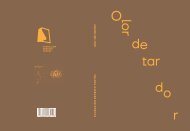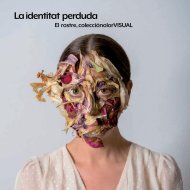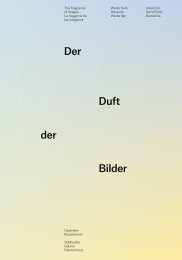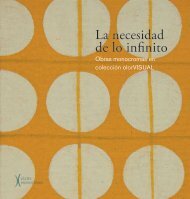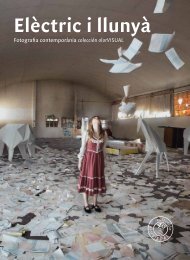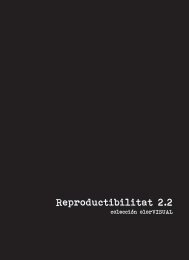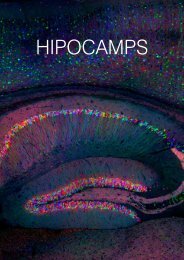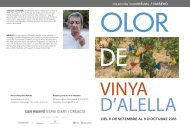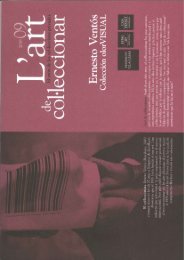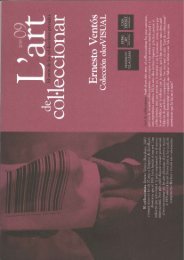You also want an ePaper? Increase the reach of your titles
YUMPU automatically turns print PDFs into web optimized ePapers that Google loves.
appear at all times. We can detect something similar in Zhang Huan, or in the<br />
Baroque-ism of Wolfgang Tillmans drawing from Arcimboldo, in Carmen<br />
Calvo and in the work of Kuitca.<br />
As this happens, we continue to feed the ruin with a constructive abyss,<br />
always without time to reflect on our condition, on our identity. Meantime,<br />
Lewis Mumford wonders: “Will the city disappear or will the whole planet turn<br />
into a vast urban hive? – which would be another mode of disappearance”.<br />
The result would not be far from those hackneyed news items on hurricanes<br />
and Wall Street actions posed by Andrei Roiter or the scent of explosions and<br />
fireworks ironically dealt with by Pedro G. Romero. Or the representations of<br />
representations that Simeón Saiz Ruiz designs. Simeón Saiz Ruiz does not start<br />
with photographs of reality but with the impossible photography of media like<br />
television, and he shares a paradoxical premise with artists like Luc Tuymans:<br />
the static image remains in the memory longer than the moving image.<br />
The impossibility of retrieving that image, its finiteness and disappearance,<br />
accumulates meanings whose mental equivalent develop, which does remain and<br />
is increasingly in motion. We are talking about a painting of ideas, a painting<br />
that is not at all innocent, that is capable of transmitting the incongruence of<br />
the world of the media, its virtual veracity. We are also talking about a kind of<br />
painting that emerges from a slow process: first he photographs the television,<br />
then the resulting image is photographed again several times to be precisely<br />
extrapolated onto the canvas, reproducing each pixel with its exact chromatic<br />
values. The concrete seems to melt into a kind of abstract tapestry, but the<br />
memory of violence does not; it remains intact. In the works by Simeón Saiz<br />
Ruiz, the scene gets back the narrative and informative capacity of the painting<br />
of history, even when it is done based on a criticism of the current mechanisms<br />
through which information is transmitted.<br />
In short, it is as if progress ends up devouring us. We might think about<br />
the Klee painting Angelus Novus and the words of Walter Benjamin: “It depicts<br />
an angel looking as though he is about to move away from something he<br />
is fixedly contemplating (…) His face is turned toward the past. Where we<br />
perceive a chain of events, he sees one single catastrophe that keeps piling<br />
ruin upon ruin and hurls it in front of his feet (…) The storm irresistibly<br />
propels him into the future to which his back is turned, while the pile of<br />
debris before him grows skyward. This storm is what we call progress.” That<br />
progress is a kind of contemporary abyss which can be seen in art through<br />
colour, through form, but also through scent, that which smells and that<br />
which is imagined. Because all bodies have smells to which they are joined by<br />
an umbilical cord, that of sensation.<br />
David Barro<br />
Curator of the exhibition – Director of Luis Seoane Foundation<br />
Artist‘s texts<br />
Eugenio Merino<br />
The Smell of Art<br />
The senses are the most reliable medium through which to understand the<br />
meaning of the artwork. In contrast to reason, the senses offer us veracity.<br />
139




